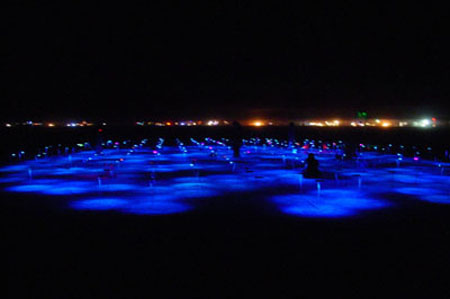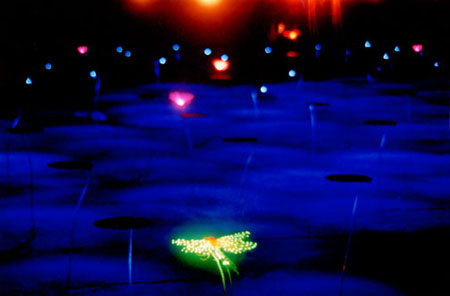The Lily Pond: an experiential adventure
by Jeremy Lutes



The Lily Pond: an experiential adventure
by Jeremy Lutes

| Jeremy Lutes The Lily Pond,circuit boards, steel, LEDs, ceramic, glass, and wire, 2002. (© Jeremy Lutes. Photo: Jeremy Lutes) |

| Dragonfly detail of The Lily Pond,wire, glass, and fiber optics, 2002. (© Jeremy Lutes. Photo: T. Timmermans) |
|
The Lily Pondwas prepared for Burning Man 2002 and as with many creative works, The Lily Pond began life as something much
different that what it has actually become. Born out of a desire to create a large scale interactive environment, the Pond was
originally conceived as a large array of electronic devices that would respond both visually and audibly to people passing near them.
Function quickly gave way to form, upon the realization that there was no reason these devices could not be sculptural as well as
functional. Prior experience with botanical sculpture led us to the idea of each device becoming a plant, and from there it was a short
leap to the concept of the lily pond.
The Lily Pond,as it exists today, consists of almost 300 lily pads, mounted 22 inches above the ground, and covering an area of roughly 3500 square feet. Each pad is actually a green circuit board, fabricated in the shape of a lily pad, and home to the various electronic circuits that give life to the Pond. The pads are arrayed in a hexagonal grid on 4-foot centers. This arrangement allows one to walk amongst the pads, with the illusion that one is wading into a knee-deep pond. The illusion of wading into a pond is greatly enhanced at night, when each lily pad projects a diffuse blue glow onto the ground beneath it. As one walks amongst the pads, they individually modulate their light levels, in effect simulating the movement of ripples on water. These ripples of light propagate out into the pond, where they collide and combine with other ripples traveling in the pond. Wanting to take the concept beyond the basic idea of a pond full of interactive lily pads, we looked to the flora and fauna of a real pond. As with most natural environments, inspiration abounds, and we found abundant material to draw from. We selected a few elements that interested us to include in the first incarnation of the Pond. Roughly two dozen of the lily pads sport lotus blossoms, made out of lamp-worked glass and stainless steel. These flowers are lit from within, and they slowly fade on and off, and change colors. Seven dragonflies, in the form of wire-frame sculptures, inhabit the Pond. The wings of the dragonflies are illuminated with fiber optics, and are animated in a way that suggests rapid motion. The glass eyes of the dragonflies are also lit, with a soft light that slowly fades on and off. A pond would not be complete without some fish, and The Lily Pondis home to several varieties. Five full-size koi, sculpted in ceramic, lurk beneath the surface, their eyes and barbles glowing gently in the night. There are four different schools of trout, also out of ceramic, as well as a dozen carp, made of kiln-cast glass. Both the trout and the carp are illuminated with miniature colored spotlights hidden beneath the lily pads. The shore of the Pond is made up of several large steel sculptures suggestive of the reeds, ferns, and grass that accompany a real pond. These sturdy sculptures also serve as a buffer zone between the vast unknown exterior world, and the quiet, contemplative space of the Pond. Breathing life, motion, and light into the Pond requires the collision of several different technologies. The light sources used to illuminate the ground are some of the latest generation of LEDs (light emitting diodes), which are rapidly becoming the most efficient light sources available. In order to produce the rippling water effect, the lily pads "talk" to one another, using infrared technology similar to that found in television remote controls. The ripple effect itself is based upon a relatively new branch of science known as "cellular automata," or CA. And finally, each lily pad contains its own power source, which is recharged every day by a set of photovoltaic solar cells. Thus the entire Pond is wireless and self-sustaining, powered by the sun. The Lily Pondrepresents a variety of techniques, technologies, materials, and creative visions. Collaborators include the Sunbrothers (lotus blossoms and solar cells), Kathleen Fernald (ceramic fish), Michael Christian (shore sculpture), Lee Kobus (glass fish) and Jay Kravitz (glass fish). Though we were not striving for strict realism in the depiction of a pond, we hope that the Pond succeeds in transcending its technology and creates a real, vibrant, and inviting space in which people can immerse themselves. Jeremy Lutes 3140 San Pablo Avenue Oakland, CA 94608 U.S.A. E-mail: tritical@speakeasy.net |
| Burning Man |
| gallery entrance |
| past exhibitions |
| Leonardo On-Line |